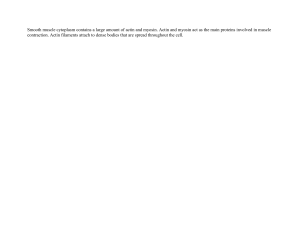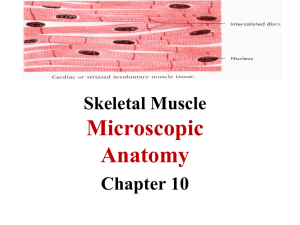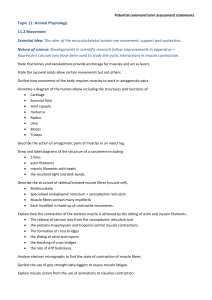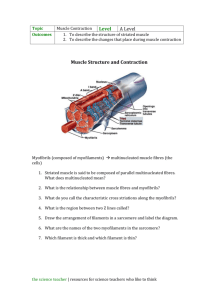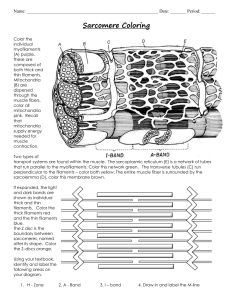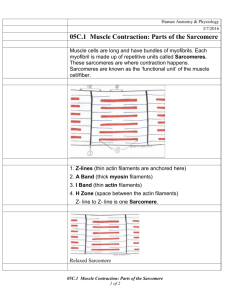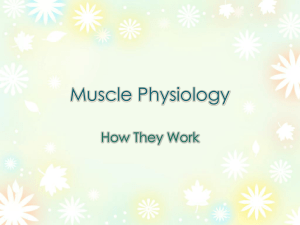Topic 6 & 11: Human Health and Physiology
advertisement
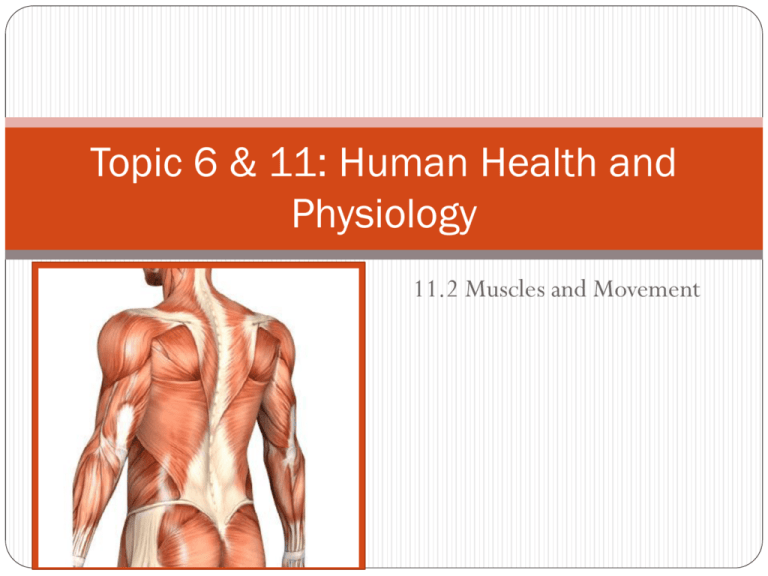
Topic 6 & 11: Human Health and Physiology 11.2 Muscles and Movement • What do you know? • What questions do you have? • How do skeletons and exoskeletons differ? 1 - Anatomy Read & Consider 11.2.1-11.2.3 Draw, label, & annotate the human elbow joint: Include: Bones Muscles Ligaments Synovial joint features Tendons Cartilage Synovial Joints Pubic Symphysis: Cartilaginous Joint Skull Suture Joint: Fibrous Joint Antagonistic Pairs Both bones and exoskeletons act as anchors for muscle and levers for movement with the use of antagonistic muscle pairs. • What do you know? • What questions do you have? • Are all types of muscle the same? 2 – Muscle Cells / Muscle Fibers Read & Consider 11.2.4-11.2.6 Muscle fibers (cells) are multinucleated cells that may shorten to half or one-third of their resting length. Fibers (cells) are composed of myofibrils contained in a plasma membrane called the sarcolemma. Cytoplasm between myofibrils contains mitochondria. Sarcolemma in-folds to form sarcoplasmic reticulum containing transverse tubules. Actin & Myosin Myofibrils are composed of interlocking thick and thin protein filaments. Thin filaments – actin – long and about 7nm in diameter. The are held together by transverse bands called Z lines. Thick filaments – myosin – short and about 15nm in diameter. Muscles are striped or striated due to the repeating pattern of actin and myosin filaments. Draw and label diagrams of the structure of a sarcomere. • What do you know? • What questions do you have? 3 - Contraction Read & Consider 11.2.7-11.2.9 Sarcomere Each repeating until of the myofibril (actin and myosin) is called a sarcomere. From z line to z line. Contraction: 1. 2. 3. 4. 5. Action potential arrives at the neuromuscular junction. Acetylcholine (neurotransmitter) released. Action potential is initiated in the muscle cell membrane. T-tubules carry this chemical signal throughout the muscle. Signal causes a calcium release from the sarcoplasmic reticulum into myofibrils. Power Stroke Calcium causes troponin (protein) to remove tropomyosin exposing cross bridge binding sites. 7. An ATP molecule “charges” the cross bridge allowing it to react with the neighboring actin molecule. 8. The use of the ATP molecule triggers a rowing movement (cross bridge tilts to 45ºn angle) pushing the actin filament along = power stroke and shortening the myofibril. 9. The cross bridge then returns to resting position, is blocked by tropomyosin, and a new ATP molecule recharges in preparation for the next contraction. 6. Diagram Muscle Contraction Analysis Works Cited Contracting Muscles. Digital image. Quick 3D Motion. Gizmag, n.d. Web. 03 Jan. 2015. Hip Joint. Digital image. WiseGEEK. Conjecture Corporation, n.d. Web. 03 Jan. 2015. Human Skeleton. Digital image. Learn: (by Xinixazi). N.p., n.d. Web. 15 Dec. 2014. Pubic Symphysis. Digital image. Pix For Pubic Symphysis. Disqus, n.d.Web. 03 Jan. 2015. Water Beetle - Exoskeleton. Digital image. Insect Exoskeleton Viewing Gallery. N.p., n.d.Web. 15 Dec. 2014. Zygote Media Group Inc. Synovial Joint. Digital image. 3D Science Clip Art. N.p., n.d.Web. 03 Jan. 2015.
